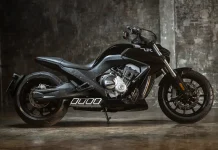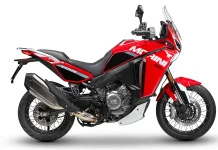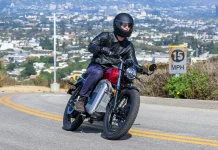Cornerspeed High-Performance Motorcycle Riding School
Anyone can go fast in a straight line. Who wouldn’t agree? But although carrying speed on a straightaway will improve lap times, it’s obvious where the best racers have the advantage – the corners. And this is exactly what Aaron Stevenson’s Cornerspeed Race School teaches…just what the name implies.
The official track school of Virginia International Raceway for the past 11 years, Cornerspeed offered their first class of 2010 on a surprisingly warm Monday in March. But instead of trucking my track machine there, I piloted a ‘98 Honda VFR Interceptor on the most desolate path possible from Northeastern Pennsylvania to VIR.
The VFR is the perfect sport touring platform for 1500-mile trips like my one to VIR, but it does not particularly perform well on the track. But after pushing the “Viffer” to its limits, I came away with more from the class than I would have with my R6 track bike or CBR 929RR. And the best part…I had a comfortable touring trip there.
Stevenson, Cornerspeed’s founder and head instructor, has his technique sharpened to an almost exact art, though it’s a bit much to absorb in one day (about 10 hours of class/track time). But knowing Stevenson worked as an AMA Pro Racing and licensed FIM official, there was extra incentive for mind absorption.
Holder of an expert racing license since 1992 and a WERA National Vintage Superbike Championship, Stevenson began the day-long session by giving an overview to the 21 students (20 males, one female), both young and old, experienced and un-experienced track riders. He first emphasized health aspects such as hydration. Being a former national-level competition cyclist, health and fitness concerns garnished each session.
“After the health concerns comes the plan of this school,” Stevenson says. “This class is designed to work on technique, smoothness and rhythm, not your fastest lap time. The speed will come later on, naturally, once these techniques are learned. But again, for any rider to be optimal, exception fitness is a must.”
The class began at 8 a.m. after everyone’s bikes were thoroughly inspected by the energetic (even at 7 in the morning) instructors. Since I rode my bike almost 800 miles the weekend leading up to the class, my chain was a bit loose and dirty. And yes, it had to be cleaned (better yet scrubbed) and adjusted before the bike was able to come near the track.
This, along with some zip-tie work, much racer tape covering lights/blinkers, and a removal of some items with the help of instructor Bill Hendrix, still made my sport tourer appear slow next to the full-out track bikes lined up. But after a few minutes in class, Stevenson’s words quickly dissolved that image.
“Regardless of what your riding you can tweak technique. As Kenny Roberts (Sr.) said, ‘learn to go slow to go fast,'” Stevenson said. “It’s all about baby steps. Ride between 70- to 80-percent of your ability, and absorb the technique.'”
Did it matter I was riding a sport touring bike? Nope…as Stevenson said, the class was all about technique, not speed. Plus, he was fastest on the track, and rode a track-prepped SV650, which added incentive. Point here?
The size/make of your machine doesn’t matter at the school (though I’d leave the heavy-weight cruisers at home). As long as you’re “listening” to what the bike tells you, all should go well when en route to perfecting technique.
In our first of eight classroom sessions, each session followed by some laps to practice the techniques, the instructors discussed mental preparation, the proper line on the track, reference points, looking far ahead down the track, and listening to your bike. The latter is part of Stevenson’s philosophy that we are not “riders” but “pilots” who must tell our machines what do and respond to their feedback.
Throughout the day, Stevenson was observed discussing this “pilot” philosophy. Twisting an imaginary throttle, he told students when the throttle is open you’re a “pilot,” and when it’s closed, you’re a “passenger.”
After I completely filled the last page of the Cornerspeed workbook with notes (I forgot my tablet due to rushing with excitement, I’d recommend remembering one), we were let loose on the track. The entire group, including me, had a nervous anticipation throughout the class sessions to get on the throttle. And this is where the fun truly began, although we wouldn’t ride at a fast pace for another two sessions.
Our first time out, we followed the instructors, each one pointing to reference points and the proper line on the track (sometimes in later sessions with their knees planted). Considering there was an instructor for about every three riders, this created a very intimate atmosphere out where you can truly test the limits of a sport, or sport touring, bike. And to further assist with technique on the 2.25-mile technical North Course, many orange cones designated reference points, where to turn in, the apex, where to exit the corner, and braking points.
Throughout the class room sessions, additional techniques were discussed, such as body (get that butt off the seat!) and hand position with an emphasis on what Stevenson calls a “Screwdriver Technique.,” Instructors also talked about looking far down the track, proper setup on bike, and proper execution of turns (brake once, turn once, accelerate once).
These sessions were further enhanced on the track, each student getting hands-on feedback from instructors riding with them. During the third session, my instructor padded his head, meaning to meet him on pit road. His gripe – I wasn’t keeping a smooth enough line through the corners. I also wasn’t using proper body positioning all the time.
“You’re choppy on the throttle,” Hendrix said. “Remember, after braking you need to be on the throttle to keep that chain tight, which will keep the chassis settled…and get that butt off the seat more! Get your head where the mirror should be, turn the hips more, and move with the core of your body…and remember, treat that gas tank like a saddle and slide around it when hanging off the bike.”
When the instructors point out your faults right there on the track, the problems are much easier to fix. I did have some issues fixing my faults during one track session, though. The most difficult for me was the no braking exercise on our fourth time out on the track. If anyone ever rode the North Course at VIR, they’ll know this is almost impossible at Turn 7; a rider carries much speed into this corner, which turns erratically while rolling uphill. I remember watching Jake Zemke in 2008 when he was in the now defunct AMA Formula XTreme class. He was braking so hard before Turn 7 his rear tire was coming what appeared to be a foot off the ground.
But no braking for this session, an exercise used to show a rider how much just getting off the throttle slows the bike down (engine braking). The instructor following me at the time, “Triple X” Steve Broadstreet, would have slapped me on the wrist if it were a grade school class in the ‘50s; the bright red showed through the white tape covering my lights about 12 times from his count, although he may have been looking far ahead of my bike as “pilots” are trained to do on the track (I know I tapped the brake at least 15 times…maybe 20).
By the end of the sessions, many riders were already physically fatigued. And though I began running around 15-20 miles a week to develop strength and endurance for racing, my legs were extremely sore. “If your legs are killing you, you’re riding correct,” Stevenson assured the class. But Stevenson had a knack for lifting spirits after an exhausting track session, getting many laughs out of all my classmates. How? Taking on the accents of Valentino Rossi, Mat Mladin, Andrea Dovizioso and even World Superbike commentator Jonathan Green. And it takes this bit of entertainment to keep a class going after many miles (well over 100 after completion) on the track.
To graduate, all students must complete a simple True/False test at the end of the day about some of the techniques they learned, and another test matching track flags with their meaning. If you pass, which everyone in the class did, you’re ready to obtain a CCS or WERA racing license.
After collecting my diploma, having to zip it under my Teknic leathers due to not bringing any luggage with me, Hendrix again helped turn my VFR back into the street machine. I rode back to the hotel, sat down with a bottle of Shiraz, and began replaying everything I learned that day. I took additional notes and read through the literature that was given to each student.
Minutes later, I began practicing another technique Stevenson taught us – the meditative way to become faster. For this technique, you close your eyes, allowing yourself to visualize each section of the track at the same speed you’d be traveling while out there. After my eyes were shut, I could visualize every corner and straightaway, imagining time at the same speed I did physically on the track.
The following day, on a butt-burning 630-mile ride, I practiced some of the techniques. I looked far ahead down the road, experimented with body positioning, and applied techniques to not upset my suspension while braking/turning. But the one technique that made me a much safer rider was Stevenson’s “Wide, Deep and Late” turn-in philosophy.
Essentially, taking a turn wide and deep, and turning late, will naturally provide visualization when approaching a blind corner. This provides a chance to choose a different line if something is obstructing the roadway. These lessons improved my smoothness on the street, and made me a more visual rider. When I pulled into my garage that night after a bit over 12 hours of riding, I would have turned around and drove another 12 just to take the class again.
As I said before, it was much to absorb in a single day…but during a track session at Pocono Raceway a few weeks later, I realized how much I actually did absorb. I was much more comfortable, which in turned equaled much, much faster lap times than before. Lessons like the ones from Cornerspeed cannot be self taught, and will ultimately make you quicker on the track. And this naturally will make you safer on the street.
The 2010 cost for Cornerspeed’s Riderschool at VIR is $465 (North Course) unless otherwise stated or in conjunction with another offer. The cost of tuition includes but is not limited to the following: Free Motul Lubricants and products (shipped direct to you by Motul), school handbook, t-shirt, lunch, water bottle and water/Gatorade throughout the day, energy drinks, discount coupons from our other sponsors, over 2 hours of track time, classroom lectures and one-on-one trackside feedback from your instructors.
For a full-schedule and additional information, visit www.cornerspeed.net











